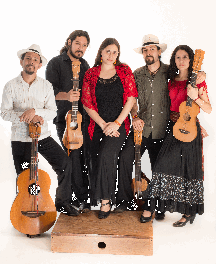
Jayna Swartzman-Brosky at the 9th Annual Santa Barbara County Symposium for the Arts, photo by Leslie Dinaberg
Last week’s arts symposium, an annual event sponsored by The Santa Barbara County Arts Commission, served as a lively town hall of sorts for the local arts community. Arts advocates, arts educators and youth advocates, arts administrators, foundations, arts and city and county officials (and yours truly) packed the meeting rooms at the Canary Hotel for a day packed full of presentations and opportunities for the arts community to discuss issues that impact the arts in Santa Barbara.
Talented Goleta Valley Junior High student Mary-Grace Langhorne, the 2014 Teen Star (one of many youth-centric arts programs supported by the Arts Commission) awed the crowd with a beautiful song, followed by a short welcome from Ginny Brush, executive director of the Arts Commission. Next up was Santa Barbara Mayor Helene Schneider, who led us in a rain dance of sorts. If only I had a video camera … Santa Barbara Poet Laureate Chryss Yost read a moving poem by the city’s first Poet Laureate, the recently-deceased Barry Spacks. This was especially fitting since April is National Poetry Month.
This year’s focus for the arts symposium was “Expanding Advocacy, Community Engagement and Investment in the Arts,” and keynote speaker Kerry Adams Hapner, executive director of the Office of Cultural Affairs for the City of San Jose, gave an excellent presentation spotlighting what San Jose has done to bring the arts to the forefront of that city’s economic development program.
 Basically, the San Jose model outlined ten goals for ten years. Number one was to support the resident’s personal participation in arts and culture. Number two: to support availability of diverse cultural spaces and places throughout the community. Number three was to strengthen downtown San Jose as the creative and cultural center of the region. Number four: integrate public art and urban design throughout the community. Number five: expand residents’ access. Number six was to foster destination quality events in San Jose. Number seven: strengthen marketing and engagement. Number eight was to enhance support for creative entrepreneurs and the commercial creative sector. Number nine, to strengthen the cultural community’s infrastructure. And finally, number ten, to increase funding.
Basically, the San Jose model outlined ten goals for ten years. Number one was to support the resident’s personal participation in arts and culture. Number two: to support availability of diverse cultural spaces and places throughout the community. Number three was to strengthen downtown San Jose as the creative and cultural center of the region. Number four: integrate public art and urban design throughout the community. Number five: expand residents’ access. Number six was to foster destination quality events in San Jose. Number seven: strengthen marketing and engagement. Number eight was to enhance support for creative entrepreneurs and the commercial creative sector. Number nine, to strengthen the cultural community’s infrastructure. And finally, number ten, to increase funding.
What Hapner described as “working the plan” involved a number of partnerships and strategic investments from the tech companies that define the Silicon Valley region, creating a creative industries incentive fund to attract that type of business and allocating 1% of the city capital improvement projects to public art, among other strategies.
The second presentation was by Jayna Swartzman-Brosky, program director for the Center for Cultural Innovation. One of the programs she oversees is NextGen Arts, a grant program of which provides professional development grants and resources for emerging California arts leaders between the ages of 18-35. She also manages the Creative Capacity Fund Quick Grant Program, which provides reimbursement funds to nonprofit organizations and individual artists to enroll in workshops, attend conferences, and to work with consultants and coaches to build administrative and business skills and strengthen the economic sustainability of an organization or arts practice. The organization offers a number of low cost entrepreneurial workshops, practical publications and resources for artists and arts organizations, with loads of information available online as well.
Afternoon sessions were divided into smaller breakout groups to stimulate community dialogue and included a more in-depth discussion with Swartzman-Brosky, a panel on promoting arts education advocacy, a group focused on expanding Santa Barbara’s cultural footprint through collaborative marketing/promotion and a discussion of advocacy for artists/innovators.
All in all it was an invigorating and interesting day. For more information visit sbartscommission.org.
—Leslie Dinaberg
Originally published in Santa Barbara SEASONS on April 22, 2014.

